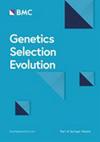Genomic prediction of blood biomarkers of metabolic disorders in Holstein cattle using parametric and nonparametric models
IF 3.6
1区 农林科学
Q1 AGRICULTURE, DAIRY & ANIMAL SCIENCE
引用次数: 0
Abstract
Metabolic disturbances adversely impact productive and reproductive performance of dairy cattle due to changes in endocrine status and immune function, which increase the risk of disease. This may occur in the post-partum phase, but also throughout lactation, with sub-clinical symptoms. Recently, increased attention has been directed towards improved health and resilience in dairy cattle, and genomic selection (GS) could be a helpful tool for selecting animals that are more resilient to metabolic disturbances throughout lactation. Hence, we evaluated the genomic prediction of serum biomarkers levels for metabolic distress in 1353 Holsteins genotyped with the 100K single nucleotide polymorphism (SNP) chip assay. The GS was evaluated using parametric models best linear unbiased prediction (GBLUP), Bayesian B (BayesB), elastic net (ENET), and nonparametric models, gradient boosting machine (GBM) and stacking ensemble (Stack), which combines ENET and GBM approaches. The results show that the Stack approach outperformed other methods with a relative difference (RD), calculated as an increment in prediction accuracy, of approximately 18.0% compared to GBLUP, 12.6% compared to BayesB, 8.7% compared to ENET, and 4.4% compared to GBM. The highest RD in prediction accuracy between other models with respect to GBLUP was observed for haptoglobin (hapto) from 17.7% for BayesB to 41.2% for Stack; for Zn from 9.8% (BayesB) to 29.3% (Stack); for ceruloplasmin (CuCp) from 9.3% (BayesB) to 27.9% (Stack); for ferric reducing antioxidant power (FRAP) from 8.0% (BayesB) to 40.0% (Stack); and for total protein (PROTt) from 5.7% (BayesB) to 22.9% (Stack). Using a subset of top SNPs (1.5k) selected from the GBM approach improved the accuracy for GBLUP from 1.8 to 76.5%. However, for the other models reductions in prediction accuracy of 4.8% for ENET (average of 10 traits), 5.9% for GBM (average of 21 traits), and 6.6% for Stack (average of 16 traits) were observed. Our results indicate that the Stack approach was more accurate in predicting metabolic disturbances than GBLUP, BayesB, ENET, and GBM and seemed to be competitive for predicting complex phenotypes with various degrees of mode of inheritance, i.e. additive and non-additive effects. Selecting markers based on GBM improved accuracy of GBLUP.利用参数和非参数模型对荷斯坦牛代谢紊乱血液生物标志物进行基因组预测
由于内分泌状态和免疫功能的变化,代谢紊乱会对奶牛的生产和繁殖性能产生不利影响,从而增加患病风险。这种情况可能发生在产后阶段,也可能发生在整个哺乳期,并伴有亚临床症状。最近,人们越来越关注提高奶牛的健康水平和抗病能力,而基因组选择(GS)可能是一种有用的工具,可用于选择在整个泌乳期对代谢紊乱更具抗病能力的动物。因此,我们对使用 100K 单核苷酸多态性(SNP)芯片分析法进行基因分型的 1353 头荷斯坦牛的代谢紊乱血清生物标志物水平的基因组预测进行了评估。使用参数模型最佳线性无偏预测(GBLUP)、贝叶斯B(BayesB)、弹性网(ENET)和非参数模型梯度提升机(GBM)以及结合了ENET和GBM方法的堆叠集合(Stack)对GS进行了评估。结果表明,Stack 方法优于其他方法,与 GBLUP 相比,其相对差异(RD)(以预测准确率增量计算)约为 18.0%;与 BayesB 相比,约为 12.6%;与 ENET 相比,约为 8.7%;与 GBM 相比,约为 4.4%。与 GBLUP 相比,其他模型预测准确率的最高 RD 是血红蛋白 (hapto),从 BayesB 的 17.7% 到 Stack 的 41.2%;锌从 9.8%(BayesB)到 29.3%(Stack);锰从 9.8%(BayesB)到 29.3%(Stack)。3%(Stack);脑磷脂蛋白(CuCp)从 9.3%(BayesB)升至 27.9%(Stack);铁还原抗氧化能力(FRAP)从 8.0%(BayesB)升至 40.0%(Stack);总蛋白(PROTt)从 5.7%(BayesB)升至 22.9%(Stack)。使用从 GBM 方法中选出的顶级 SNPs 子集(1.5k),GBLUP 的准确率从 1.8% 提高到 76.5%。然而,在其他模型中,ENET(10 个性状的平均值)的预测准确率降低了 4.8%,GBM(21 个性状的平均值)降低了 5.9%,Stack(16 个性状的平均值)降低了 6.6%。我们的研究结果表明,Stack 方法在预测代谢紊乱方面比 GBLUP、BayesB、ENET 和 GBM 更准确,而且在预测具有不同程度遗传模式(即加成和非加成效应)的复杂表型方面似乎更有竞争力。根据 GBM 选择标记物提高了 GBLUP 的准确性。
本文章由计算机程序翻译,如有差异,请以英文原文为准。
求助全文
约1分钟内获得全文
求助全文
来源期刊

Genetics Selection Evolution
生物-奶制品与动物科学
CiteScore
6.50
自引率
9.80%
发文量
74
审稿时长
1 months
期刊介绍:
Genetics Selection Evolution invites basic, applied and methodological content that will aid the current understanding and the utilization of genetic variability in domestic animal species. Although the focus is on domestic animal species, research on other species is invited if it contributes to the understanding of the use of genetic variability in domestic animals. Genetics Selection Evolution publishes results from all levels of study, from the gene to the quantitative trait, from the individual to the population, the breed or the species. Contributions concerning both the biological approach, from molecular genetics to quantitative genetics, as well as the mathematical approach, from population genetics to statistics, are welcome. Specific areas of interest include but are not limited to: gene and QTL identification, mapping and characterization, analysis of new phenotypes, high-throughput SNP data analysis, functional genomics, cytogenetics, genetic diversity of populations and breeds, genetic evaluation, applied and experimental selection, genomic selection, selection efficiency, and statistical methodology for the genetic analysis of phenotypes with quantitative and mixed inheritance.
 求助内容:
求助内容: 应助结果提醒方式:
应助结果提醒方式:


